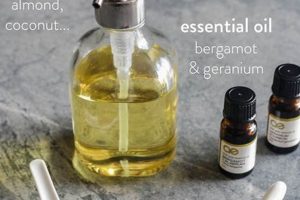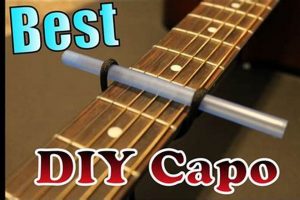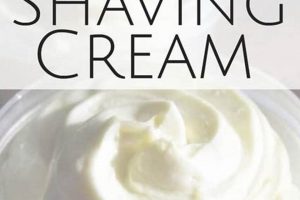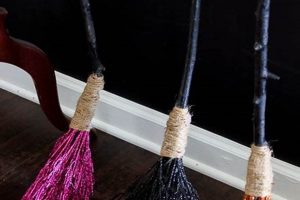These commercially available sets provide the necessary tools and materials for individuals to address minor damage to automotive glass, such as small chips and cracks. The contents typically include a resin adhesive, an applicator, curing strips, and instructions for achieving a suitable repair. An example of damage suitable for this type of intervention would be a star-shaped break smaller than a quarter.
The significance of addressing even minor windshield damage lies in maintaining structural integrity and preventing further crack propagation, which can impair visibility and necessitate full windshield replacement. The use of these kits represents a cost-effective alternative to professional auto glass services, particularly for small, isolated instances of damage. Historically, such repairs were exclusively performed by specialized technicians, but the emergence of these accessible tools empowers vehicle owners to undertake the process themselves.
The subsequent sections will examine the specific components included within these sets, detail the recommended procedures for their effective implementation, and provide a critical evaluation of their suitability for various types of windshield damage. Furthermore, safety considerations and potential limitations associated with their application will be discussed.
Guidance for Effective Windshield Damage Mitigation
The subsequent recommendations are designed to enhance the likelihood of successful intervention when utilizing a commercially available set for automotive glass preservation.
Tip 1: Ambient Conditions: Adherence to specified temperature ranges during the application process is crucial. Inadequate temperatures may compromise resin curing and bond strength.
Tip 2: Surface Preparation: Thorough cleaning of the damaged area is paramount. Remove any loose debris or glass fragments prior to resin injection to ensure optimal adhesion.
Tip 3: Controlled Application: Exercise precision when injecting resin into the damaged area. Overfilling can lead to cosmetic imperfections; underfilling can compromise the structural repair.
Tip 4: Curing Process: Proper curing of the resin is essential for achieving a durable bond. Allow the resin to cure for the time specified by the manufacturer, utilizing the provided curing strips and, if applicable, UV light source.
Tip 5: Inspection and Evaluation: Post-curing, carefully inspect the repaired area for any remaining air pockets or imperfections. Additional resin may be required for optimal results.
Tip 6: Timely Action: Addressing damage promptly is beneficial. Delayed intervention allows contaminants to infiltrate the break, potentially hindering the repair process.
Tip 7: Evaluate Damage Type: The type and size of the damage are crucial factors. These sets are generally intended for small, non-complex breaks. Consult a professional for more extensive damage.
Following these guidelines significantly increases the chance of achieving a structurally sound and aesthetically pleasing repair, thereby extending the lifespan of the windshield and mitigating the risk of further damage propagation.
The concluding section will synthesize the information presented and offer a comprehensive perspective on the overall value proposition associated with employing these kits.
1. Resin Adhesion
Resin adhesion is a critical parameter influencing the efficacy and longevity of repairs achieved using a commercially available set. The strength of the bond formed between the resin and the existing windshield glass directly determines the repair’s ability to prevent further crack propagation and restore structural integrity to the damaged area.
- Surface Preparation Influence
The cleanliness and preparation of the windshield surface significantly impact resin adhesion. Contaminants such as dirt, oil, or loose glass fragments impede the resin’s ability to form a strong bond. Thorough cleaning with an appropriate solvent is therefore a prerequisite for successful application.
- Resin Chemistry Composition
The specific chemical composition of the resin used in these sets dictates its adhesive properties. Variations in resin formulations influence the resin’s viscosity, curing rate, and ultimately, its ability to penetrate and bond to the glass matrix. Lower quality resin could translate to weaker bond, leading to repair failure.
- Application Technique Importance
The method of resin application plays a crucial role in promoting adhesion. Proper filling of the damaged area, ensuring complete saturation and the removal of air pockets, is essential for maximizing the contact area between the resin and the glass. Inadequate technique can result in incomplete bonding and compromised structural support.
- Environmental Conditions Impact
Ambient temperature and humidity levels during the application and curing process can affect resin adhesion. Extreme temperatures or high humidity may interfere with the resin’s curing process, resulting in a weaker and less durable bond. Adherence to the manufacturer’s recommended environmental parameters is therefore imperative.
In summary, the ultimate success of such automotive glass interventions hinges directly on the strength and durability of the resin bond. The interplay of surface preparation, resin chemistry, application technique, and environmental conditions dictates the quality of this bond and consequently, the longevity of the windshield preservation measure.
2. Damage Assessment
Effective utilization of automotive glass preservation sets necessitates a thorough evaluation of the damage. The size, type, and location of the damage are critical factors determining the suitability of this approach. For instance, a small star break located away from the windshield’s edge may be amenable to repair. Conversely, a long crack or damage situated within the driver’s line of sight typically warrants complete windshield replacement. Misjudging the extent of the damage can lead to ineffective repairs or, worse, exacerbate the problem, potentially compromising structural integrity and impacting driver safety. For example, attempting to repair a crack exceeding the manufacturer’s recommended length risks incomplete bonding and subsequent crack propagation.
The success of any glass preservation intervention is inherently linked to accurate damage assessment. The kit’s resin is formulated to address specific types of damage, typically minor chips and cracks. Undertaking a repair without properly identifying the damage type can lead to unsatisfactory results and potential safety hazards. Real-world scenarios illustrate the practical significance of this understanding: A bullseye crack, characterized by a circular impac
t point, might be successfully addressed with a glass preservation set. However, a combination break, featuring both a bullseye and radiating cracks, may require professional intervention due to its complexity and potential for further propagation. Moreover, internal layers of the windshield’s laminate are not addressable using these sets.
In summary, thorough damage assessment is a non-negotiable prerequisite for employing such automotive glass preservation sets. Accurate evaluation ensures the appropriateness of this solution, mitigates the risk of further damage, and ultimately contributes to driver safety and cost-effectiveness. The proper identification of damage parameters ensures that the limitations of the method are not exceeded, resulting in successful repairs and preserving windshield integrity. The inability to properly assess damage can also cause unintended damage when improper techniques are utilized for damage the set is not intended for.
3. Application Technique
The effectiveness of a commercially available set for automotive glass repair hinges significantly on the application technique employed. The inherent purpose of the kit, to arrest crack propagation and restore structural integrity to minor windshield damage, is directly affected by the precision and adherence to recommended procedures during application. For example, inadequate cleaning of the impact point prior to resin injection compromises the resin’s bonding capability, potentially leading to a failed repair and continued cracking. The kit’s success is not solely dependent on its components but on the user’s proficiency in their utilization.
A common error during application involves insufficient vacuum creation within the repair bridge, a tool designed to draw air from the damaged area. Failure to achieve adequate vacuuming prevents complete resin penetration, leaving air pockets that weaken the repair and diminish optical clarity. Conversely, over-tightening the injector can cause undue stress on the surrounding glass, potentially exacerbating the initial damage or creating new cracks. Real-world scenarios demonstrate that proper alignment of the injector over the damage point is crucial. Misalignment results in uneven resin distribution and a structurally compromised repair, requiring subsequent professional intervention and increasing overall costs.
In summation, the application technique constitutes a critical variable determining the outcome of a “diy windshield repair kit”. Adherence to the manufacturer’s instructions, coupled with a meticulous and controlled approach, is essential for achieving a successful repair and preserving the windshield’s structural integrity. Neglecting proper technique not only diminishes the likelihood of a satisfactory outcome but may also exacerbate the damage, necessitating costly professional repairs. The interplay between the quality of the kit’s components and the user’s skillful application technique is paramount in realizing the intended benefits of this approach to automotive glass preservation.
4. Curing Time
Curing time represents a critical parameter dictating the ultimate success and durability of repairs performed using such automotive glass preservation sets. This defined period allows the resin adhesive to undergo chemical cross-linking, solidifying and bonding with the damaged windshield to restore structural integrity. Insufficient curing compromises the resin’s mechanical properties, potentially leading to repair failure and crack propagation.
- Temperature Dependence
Curing time is intrinsically linked to ambient temperature. Lower temperatures retard the curing process, necessitating extended durations to achieve optimal resin hardening. Conversely, excessively high temperatures can accelerate curing, potentially leading to premature hardening and compromised adhesion. The manufacturer’s specifications regarding temperature ranges must be strictly adhered to for effective repairs. An example would be a curing time of 30 minutes at 75F which could extend to an hour or more at 60F.
- UV Exposure Influence
Many sets utilize ultraviolet (UV) light to initiate and accelerate the curing process. Exposure to UV light triggers the polymerization of the resin, solidifying it within the damaged area. Inadequate UV exposure results in incomplete curing and a weaker bond. The intensity and duration of UV exposure must align with the kit’s instructions to ensure optimal resin hardening. A repair conducted on a cloudy day without supplemental UV light may require significantly longer curing time.
- Resin Formulation Impact
The specific chemical formulation of the resin directly affects its curing time. Different resin compositions exhibit varying curing rates, necessitating specific durations to achieve complete hardening. Deviation from the recommended curing time for a particular resin can compromise the repair’s structural integrity. A fast-curing resin may require only 15 minutes under UV light, whereas a standard resin might need 30 minutes.
- Environmental Contamination Effects
The presence of contaminants, such as moisture or debris, within the damaged area can impede the curing process. These contaminants interfere with the resin’s ability to properly bond with the glass, potentially prolonging curing time and weakening the final repair. Thorough cleaning of the damaged area prior to resin application is essential for optimal curing. A repair attempted on a wet windshield may experience significantly prolonged curing and reduced adhesion.
The interrelation between curing time, temperature, UV exposure, resin formulation, and environmental cleanliness underscores the importance of meticulous adherence to the manufacturer’s guidelines. Proper execution of the curing process is paramount in achieving a durable and structurally sound repair with such automotive glass preservation kits, thereby prolonging the lifespan of the windshield and ensuring driver safety.
5. Structural Integrity
Structural integrity represents a paramount concern when employing a commercially available set for automotive glass preservation. The primary objective of using such a kit is to restore a degree of structural soundness to a damaged windshield, mitigating the risk of further crack propagation and potential catastrophic failure. The resin used in these kits acts as a bonding agent, filling voids within the damaged area and creating a cohesive link between fractured glass segments. This restored cohesion enhances the windshield’s ability to withstand stress and external forces, thereby contributing to the vehicle’s overall safety profile. A poorly executed repair, however, can compromise the windshield’s structural integrity, potentially exacerbating the initial damage and increasing the likelihood of complete windshield failure in the event of an impact or sudden temperature change. Consider a scenario where a windshield sustains a small chip from a road debris impact. If left unaddressed, this seemingly minor damage can gradually expand into a significant crack, severely weakening the windshield’s ability to withstand further stress. A properly applied such automotive
glass preservation set fills the chip, preventing the crack from spreading and restoring a measure of the windshield’s original strength.
The effectiveness of these kits in restoring structural integrity depends on several factors, including the size and type of damage, the quality of the resin used, and the skill with which the repair is executed. While these kits are generally suitable for addressing small chips and cracks, they are not intended for repairing extensive damage or damage located in critical areas, such as the driver’s line of sight. In such cases, professional windshield replacement is typically the only viable option to ensure adequate structural integrity and driver safety. Moreover, the type of damage dictates the effectiveness. The structure of a bullseye crack or star break often aligns with a high rate of success. Meanwhile, longer cracks are prone to failure with such a kit, creating additional unseen issues. A small section of damage along the edge of a windshield, which supports the roof of the vehicle, creates a serious situation, requiring professional assistance for safety.
In summary, such glass preservation sets offer a potential means of restoring structural integrity to minor windshield damage, provided that the damage is properly assessed and the repair is executed according to the manufacturer’s instructions. However, these kits are not a substitute for professional windshield repair or replacement in cases of extensive damage or damage affecting critical areas of the windshield. The decision to use such a kit should be based on a careful evaluation of the damage and a clear understanding of the kit’s limitations, with driver safety remaining the paramount consideration. It is essential to acknowledge that even a successfully executed repair may not fully restore the windshield to its original strength, and periodic inspections are advisable to monitor for any signs of further crack propagation. The choice of such a kit versus professional assistance, involves safety, liability and a proper understanding of auto glass functionality.
6. Visibility Restoration
The restoration of clear and unobstructed visibility through the windshield is a primary objective when utilizing a commercially available set. Damage such as chips, cracks, or bullseyes, even when minor, can scatter light, creating glare and visual distortions that impede the driver’s ability to perceive hazards effectively. These visual impairments increase the risk of accidents, particularly in low-light conditions or during inclement weather. Such commercially available kits are designed to mitigate these visibility issues by filling the damaged area with a resin that closely matches the refractive index of the surrounding glass. This process minimizes light scattering and restores a degree of optical clarity. For instance, a driver whose commute frequently involves navigating through areas with morning sun glare may find such a kit helpful in addressing a small chip that is causing significant distraction.
The extent to which visibility can be restored depends on several factors, including the size, location, and complexity of the damage. Smaller, simpler damages generally yield better results in terms of visibility restoration compared to larger, more complex cracks. Additionally, the quality of the resin and the precision of the application technique play crucial roles. An unevenly applied resin can introduce new distortions, negating the intended benefits. It is also important to note that even a successful repair may not fully restore the windshield to its original pristine condition, and a slight visual imperfection may remain. This is especially true for damages that have been present for an extended period, as dirt and debris can become embedded within the break, hindering the resin’s ability to fully fill the void. A truck driver experiencing minor visibility issues, for example, may be satisfied with the outcome, as long as the restored view doesn’t create larger visibility problems, like sun flares.
In conclusion, the role of these sets in visibility restoration is significant, though not absolute. While these kits can effectively address minor windshield damage and improve optical clarity, their limitations must be acknowledged. The success in this aspect hinges on appropriate damage assessment, proper application technique, and realistic expectations regarding the degree of restoration achievable. Furthermore, the driver must consider the long-term durability of the repair and potential need for professional intervention if the damage worsens or visual impairments persist. Prioritizing driver safety dictates a commitment to assessing and addressing any windshield damage promptly, whether through DIY intervention or professional services.
7. Cost Effectiveness
The assessment of cost-effectiveness constitutes a critical element in evaluating the viability of a “diy windshield repair kit”. This metric weighs the financial investment against the anticipated benefits, providing a framework for informed decision-making. The economic advantage of utilizing these kits derives from their potential to avert the considerably higher expense associated with professional windshield replacement or more extensive repairs necessitated by neglected damage.
- Upfront Investment Comparison
The initial financial outlay for a “diy windshield repair kit” is substantially lower compared to engaging professional auto glass services. The kits typically range in price from $10 to $30, while professional repairs can cost upwards of $100 or more, depending on the severity and location of the damage. This differential makes these kits an attractive option for budget-conscious vehicle owners facing minor windshield imperfections.
- Prevention of Escalating Damage
Timely intervention with a “diy windshield repair kit” can prevent minor damage from escalating into more significant structural compromises. A small chip or crack, if left unattended, can spread due to temperature fluctuations, road vibrations, or minor impacts. This progression necessitates more extensive and costly repairs, potentially culminating in complete windshield replacement. Proactive use of a “diy windshield repair kit” can effectively arrest this progression, saving considerable expense in the long term.
- Mitigation of Insurance Claims
Addressing minor windshield damage with a “diy windshield repair kit” can preclude the need to file an insurance claim. While some insurance policies cover windshield repairs, filing a claim may result in increased premiums or the loss of discounts. By resolving the issue independently, vehicle owners can preserve their insurance rates and avoid the administrative burden associated with claims processing. This advantage is particularly relevant for individuals with high deductibles or those concerned about maintaining a clean driving record.
- Long-Term Cost Avoidance
The long-term cost benefits of utilizing a “diy windshield repair kit” extend beyond the immediate financial savings. A properly executed repair can prolong the lifespan of the windshield, delaying the need for replacement. This extended lifespan translates into a reduction in the overall cost of vehicle maintenance and operation. Moreover, a well-maintained windshield enhances vehicle safety and resale value, further contributing to the long-term economic advantage of using these ki
ts.
In conclusion, the cost-effectiveness of a “diy windshield repair kit” hinges on the balance between the initial investment and the potential savings realized through damage prevention, insurance claim avoidance, and extended windshield lifespan. While these kits may not be suitable for all types of windshield damage, they represent a viable and economically prudent option for addressing minor imperfections and preserving the structural integrity of automotive glass.
Frequently Asked Questions Regarding “diy windshield repair kit”
The following section addresses common inquiries and misconceptions surrounding the usage and efficacy of automotive glass repair sets.
Question 1: What types of windshield damage are suitable for repair with these kits?
These kits are designed for minor damage, such as small chips (less than one inch in diameter) and cracks (typically less than three inches in length). Damage located near the edge of the windshield or within the driver’s critical viewing area may not be suitable.
Question 2: Is the structural integrity of the windshield fully restored after using this method?
While these kits can improve the windshield’s structural integrity by preventing further crack propagation, they may not fully restore it to its original strength. Professional repair or replacement may be necessary for significant damage.
Question 3: What tools and materials are included in a typical kit?
A standard kit typically includes a resin applicator, resin adhesive, curing strips, a vacuum bridge (optional), and detailed instructions. Some kits may also include a cleaning solution and a UV light for accelerated curing.
Question 4: What safety precautions should be observed during the repair process?
It is essential to wear safety glasses and gloves to protect against potential chemical exposure or glass fragments. Work in a well-ventilated area and avoid direct skin contact with the resin. Follow the manufacturer’s instructions carefully.
Question 5: How long does it typically take to complete a windshield repair using this kit?
The repair process generally takes between 30 minutes to an hour, including preparation, application, and curing time. The exact duration depends on the complexity of the damage and the specific instructions provided with the kit.
Question 6: Are there any potential drawbacks or limitations to consider?
These kits may not be effective for all types of damage, and the aesthetic outcome may not always be perfect. Inexperienced users may encounter difficulties achieving optimal results. Professional repair offers a more comprehensive and guaranteed solution in many cases.
These FAQs offer a concise overview, further sections of this document offer enhanced and deeper insights.
The subsequent discussion shifts to a comprehensive exploration of the potential risks and limitations associated with these kits.
Conclusion
The preceding analysis has dissected the multifaceted aspects of the “diy windshield repair kit”, emphasizing its functionality, potential benefits, and inherent limitations. From evaluating damage types to scrutinizing resin adhesion, application techniques, curing processes, and the restoration of structural integrity and visibility, a comprehensive framework has been established. Furthermore, the cost-effectiveness of these kits has been explored, alongside responses to frequently asked questions and an examination of potential risks.
Ultimately, the informed utilization of a “diy windshield repair kit” necessitates a balanced understanding of its capabilities and constraints. While offering a potentially economical solution for minor windshield damage, these kits are not universally applicable. Prudent decision-making demands a thorough assessment of damage parameters, adherence to manufacturer guidelines, and a realistic expectation of achievable outcomes. When in doubt, consulting with a qualified auto glass professional remains the responsible course of action to ensure both vehicle safety and structural soundness. The assessment whether a “diy windshield repair kit” is appropriate depends on the user understanding all of the prior details.







